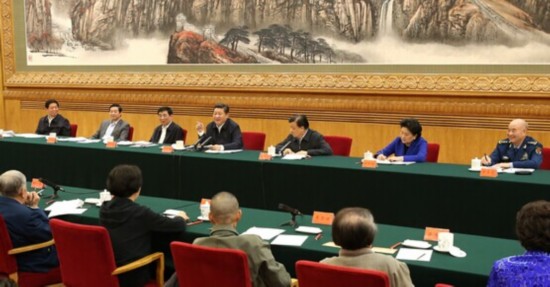On Oct 15, General Secretary of the Communist Party of China and President of China Xi Jinping invited 72 important figures from the “official” Chinese art world to Beijing for a symposium. Many of the participants hold important positions within official Chinese arts and cultural institutions—official institutions under close supervision of the Party and the government—including Fan Di’an (the newly appointed President of the Central Academy of Fine Arts), Jin Shangyi (Chairman of the China Artists’ Association), and Xu Jiang (Principal of the China Academy of Fine Arts in Hangzhou). Within the Chinese political context, every aspect of such events are carefully mulled over—including participants and speaking times—so it is unsurprising that this meeting was rated “out of the ordinary” and “a rare sight in the art world” due to the presence of Xi Jinping and the length of his speech (2.5 hours long).
In Xi Jinping’s view, China’s “Reform and Opening Up” has not only opened up the country’s cultural marketplace but has also brought with it some pressing concerns. Officialspeak abounded: “(Some works) are of sufficient quantity yet lack quality. There are many plateaus but few peaks; there are issues of too much imitation and monotony as well as a trend towards mechanized production and ‘fast-food’ consumption.” “Art and culture should not be subject to the market, and should not be tainted with a commercial air”. “Popularity is not vulgarity, desire does not represent hope, and base pleasure for the senses is not spiritual happiness.” “We should not tailor Chinese aesthetics to Western theories, and more importantly, we cannot allow business standards to replace art standards.” He went on to provide an evaluation criterion for artwork: “a good work of art should first and foremost benefit society, unifying social and economic benefits.”

While it has become customary since 1979 for the Party to participate in literature and art forums, the last time a Party leader headed such a forum was when Mao Zedong led the Yan’an Forum on Literature and Art in 1942. During that forum, Mao emphasized “many who work in art and literature have distanced themselves from the masses, leading empty lives” and “art and literature should serve the workers, farmers, and soldiers.” The speech had profound consequences on artistic production under Mao’s rule, with art placed directly under the service of politics and political reality; in the parlance, art workers are the “engineers of the soul”. Seventy years later, Xi Jinping once again made it clear who art and literature should serve, saying, “the battle lines of art and literature are important to the party and the people” and “art gives wings to the imagination, but we must keep our feet firmly rooted to solid ground.” Of course, it is as yet unclear what if any consequences President Xi’s speech will have.
On the website of People’s Daily (a party mouthpiece), the General Secretary’s speech was framed as a munificent interest in literature and arts. It was highlighted how earlier this year, while in Russia and France, Xi Jinping disclosed his reading list, which included Russian masters like Pushkin, Gogol, Turgenev, Dostoyevsky, Chekhov, among many others, as well as Enlightenment thinkers like Montesquieu, Voltaire, Rousseau, Diderot, Saint-Simon, as well as Stendhal, Balzac, Romain Roland. It is unclear what if any effects his reading has on his governance of the People’s Republic. Tocqueville’s The Ancien Régime and the French Revolution, however, was not mentioned (the book had become an unlikely bestseller in China in 2013 after being recommended by Politburo Standing Committee member Wang Qishan)[link].
Xi Jinping has been vigorously combating corruption since taking office, propagating an “anti-hedonistic” campaign within the Party. Clearly, as the art world has become more and more commercialized, it has also become an object of vigilance in this context. The implementation of anti-corruption policies has already shrunk the domestic luxury goods market, but its impact on the contemporary art market has yet to be seen. Certainly, many corrupt officials have been discovered to own substantial collections of art—particularly works by “official” artists (artists with official positions in state-led art organizations and institutions), such as Zeng Fan, Han Meilin, Huang Yongyu, whose frothy market value are completely out of sync with their modest artistic value. It is possible that Xi was focused on the use of art as assets in corrupt transactions (art is portable, low-key, and fairly liquid).
Though Xi expressed “full political confidence” in artists, and stressed the importance of “respecting the creative individuality of art and literature workers”, some liberals remain worried about a high-level “takeover in command”, which might further restrict creativity in art and literature.
Overall, more expectations have been placed on artists as a group in China. After all, in support of the “Chinese Dream”, their works must “embody progressiveness, as well as the spirit of the masses. In addition, art must not distance itself from the market, while avoiding profit or overt vulgarity”.